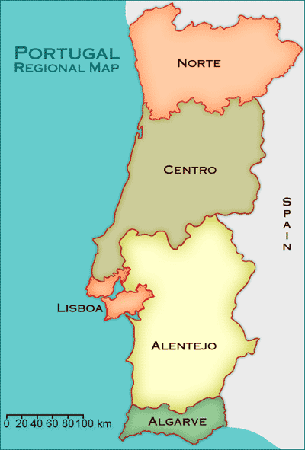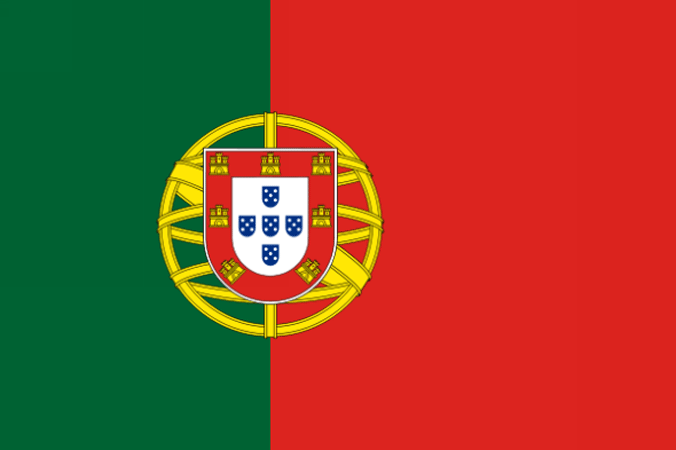Pre-Encounter and Renaissance Portugal Notes
1385 – 1521
 |
 |
|---|
I. Portugal: Early History:
During the first seven centuries of the Common Era and somewhat beyond, Portugal developed in rough parallel to Spain's development. From a part of the Roman Empire to the North African conquest of 711, Portugal adopted the Latin language, administrative structure, social organization, and religions (paganism and Christianity). In 711, Muslim invaders from Morocco conquered the entire territory of present-day Portugal. After the breakup of the Roman Empire, various Gothic or Germanic tribes from northern Europe entered, conquered, and occupied western Iberia. Then in 791, Christian Iberians from the northwest part of the peninsula began to recover lands in the north of the Portuguese region (between the Minho River—the current northern border with Spain—and the Douro River). In 1143, Portugal became a separate kingdom on the Iberian peninsula, paralleling Castilla, Aragón, Al Andalus, and others. In 1249, two and a half centuries before the parallel event in Spain, the Portuguese Christians, in a local Crusade of their own, drove the Muslims out of Portugal down through the Algarve and to their southern border. Thus, Portugal was united under one monarch and one language a century and a half before the same occurred in Spain.
II. 1385—1521
The Portuguese royal house of Avis rules from 1385 to 1521; that is, during the last century and a half of the Portuguese Middle Ages through the early transition into the Renaissance. From 1369 to 1385, the Portuguese fought three wars with Castilla, winning the last one against the Spaniards at the battle of Aljubarrota. A definitive peace with Spain was achieved by treaty in 1411.
By 1415 Portugal began expanding beyond its borders. In 1415 Portuguese forces captured Ceuta, a city enclave on the north coast of Morocco (currently a Spanish possession). During these early decades of the fifteenth century Portugal began their age of discovery, nearly a century before any other European nation. Portugal rediscovered Madeira in 1419; the Azores in 1427, Cape Bojador in 1434; and Cape Verde in 1444. The reason why Cape Bojador is significant is that it constitutes a big breakthrough for European sailors and merchantes because it pushed the sea route to the big western tip of Africa, thereby making it possible to push farther toward the desirede sea route to India. The patron on such trips of exploration was the famous Prince Henry the Navigator (Infante Henrique, duque de Vieu, 1394-1460).
A half century later, Vasco da Gama (1460 – 1524), perhaps the most successful mariner in the early Age of Discovery, commanded the first ships to sail directly from Europe to India sailed to India around the southern tip of Africa. In 1484, Columbus approached the Portuguese court at Lisbon (Lisboa) about sailing to Asia by going west. Educated persons already knew for certain that the Earth was round, but there was no certain knowledge (aside from fishermen's stories) about what land may lie between Europe and Asia. The Portuguese king João II rejected Columbus perhaps because of Columbus' unusual and arrogant personality of a foreigner but also because they Portuguese were more heavily invested in sailing around Africa and undertaking an uncertain adventure sailing due west. As a partial response to Columbus' proposal, João II selected Bartolomeu Dias (1450-1500) to sail south along the African coast. In 1487 and 1488, he became the first European to round the cape of Good Hope at the southern tip of Africa. Meanwhile, due to serious anti-Semitism in Portugal and nominally in order to unify Portugal in terms of uniformity of religion (i.e., Catholicism), all unconverted Jews were exiled from Portugal in 1497. New Christians (i.e., converted Jews) were ordered to leave Portugal in 1499, but that royal edict was lifted following pogroms in many Portuguese cities in 1506.
In 1500 Pedro Álvares Cabral (1467 - 1520) "discovered" Brazil. Sailing southwest from the Cape Verde Islands, he and his ships reached the coast of Brazil. Although he thought the area he landed on was an island, nevertheless he realized that it lay lay east of the demarcation line stipulated by Pope Alexander VI in 1493 and later confirmed by both Spain and Portugal, to the exclusion of all other European powers, by the Treaty of Tordesillas in 1494. From the Atlantic coast of Brazil, Cabral sailed southeast, reaching the Cape of Good Hope. He continued on to Mozambique in east Africa, the island of Madagascar, and finally, India. In India he traded for the spices so coveted by Europeans.
In 1507, Albuquerque conquered Ormuz (near the Strait of Hormuz in the Persian Gulf), making it, for two centuries, a colony in the Porguguese empire. In 1507, the Portuguese built a trading center and fort at Mozambique in east Africa. By 1518 the Portuguese had colonized the enclave of Goa on the western coast of India. Among many other places reached and colonized by the Portuguese during this Age of Discovery are Malacca (Malaysia), the Moluccas (an Indonesian archipelago), Timor (a large Indonesian island), China, and Colombo (Ceylon; i.e., Sri Lanka). Finally, in 1519 to 1521, Fernão de Magalhães (1480-1521), a Portuguese mariner sailing for Spain, began the first European trip to circumnavigate the globe.


